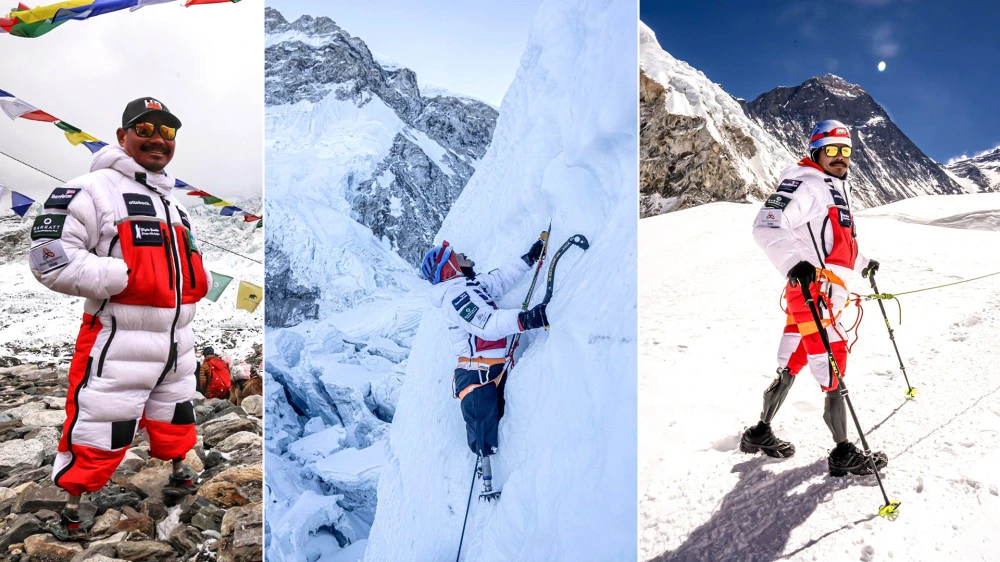Former British Gurkha soldier Hari Budha Magar, who lost both legs, successfully reached the summit of Mount Everest at 3:00 PM on the past Friday, establishing a world record. He is recognized as the first person with double above-knee amputations to summit Mount Everest. Hari Budha Magar, equipped with prosthetic legs, successfully reached the summit of Mount Everest.
After five years of dedicated effort, he accomplished his goal of climbing the highest peak in the world. Initially from Thabang Village Municipality in Rolpa, Hari Budha Magar lost both legs while serving in the British Army and was injured in Afghanistan in 2010.

Hari Budha Magar lost both legs below the knee in an improvised explosive device (IED) detonation. Hari Budha Magar, a veteran of the British Army’s Gurkha Regiment, had dedicated 15 years to serving in the regiment. However, his desire to climb Mount Everest existed before joining the military.
It was a lifelong ambition that he carried with him throughout his service. After reaching the summit of Everest, Budha Magar joyfully embraced his companions, saying, “We have succeeded.” Chris Thapa, an expedition leader from HST Adventures, played a crucial role in Budha Magar’s ascent.
During his 24 years of service, Thapa had the opportunity to climb mountains alongside the British Special Air Service (SAS). After a successful ascent through a satellite phone provided by the NSSAL Global Company, Budha Magar said, “In reality, I faced many challenges beyond my imagination, but we had to move forward.
Due to this, we faced no opposition. Regardless of the amount of suffering or the severity of the situation, we ultimately emerged victorious. Budha Magar considers his successful Everest ascent to be significant in inspiring other individuals with physical disabilities, as he believes that they are not weaker than anyone else.
He joyfully adds, “If I can climb the summit of the world, then anyone with disabilities can fulfill their dreams.” Budha Magar said, “Without the support of my family, teammates, and many people, it would not have been possible for me to climb Everest.”The North African peak of Mount Toubkal (4,167 meters), the Alps’ Mount Blanc (4,810 meters), the Far East’s Chulu (6,059 meters), Africa’s Mount Kilimanjaro (5,895 meters), and Indonesia’s Mount Merapi (6,476 meters) were all mountains that Budha Magar had to conquer before reaching the summit of Mount Everest.
In addition to that, he holds records in his name, such as reaching Everest Base Camp and skydiving above Mount Everest with a double above-knee amputation, known as the “Double Above-Knee Amputee Everest” record. In 1953, Edmund Hillary and Sherpa Tenzing Norgay made history by becoming the first individuals to reach the summit of Mount Everest.
Seventy years later, Budha Magar and his team successfully climbed Mount Everest. During Hillary and Tenzing’s ascent, Queen Elizabeth II of the United Kingdom was on a state visit, and Budha Magar’s climb coincided with King Charles III’s state visit. Budha Magar expressed, “I had planned this climb for the first time in 2018, but it feels even more special to celebrate the 70th anniversary of the first Everest ascent.” “Budhamagar was born in Mirul village of Rolpa in 1979.
Five years prior, he had faced legal restrictions in his plan to climb Mount Everest. The Mountaineering Regulation of 2059, Subsection 3, Clause 2 (c) specifically mentioned that individuals lacking both hands or feet or those with impaired vision in both eyes were prohibited from attempting the ascent of Mount Everest.
This regulation hindered Budhamagar from climbing Mount Everest.” After the court paved the way for Budhamagar’s Mount Everest ascent by interpreting the law by the provisions of Article 18, Clause 2 of the Constitution of Nepal, which prohibits discrimination based on disability, he became not only a goodwill ambassador for the Gorkha Welfare Trust but also a diplomat.
The Gorkha Welfare Trust, established in 1969, has supported the Gorkha veterans, their families, and the communities residing in Nepal in various vital areas such as education, healthcare, drinking water, and more. After the climb, most of his current life plan is to spend it in Nepal. He intends to contribute to disability awareness and economic development in Nepal.
